In his newest video Potholer54 nominates one more person to this year's Golden Crocoduck. In the video he discusses ring species, I will leave the discussion as to what they are to him but I use a similar example of ring species when trying to teach about evolution and speciation.
Friday, May 27, 2011
Thursday, May 26, 2011
David Mitchell deals with Climate Change
This was pretty funny! I wish he was wrong but David Mitchell brings up good points, I love to drive etc but unfortunately he is right.
Sunday, May 22, 2011
Museum Visit #4
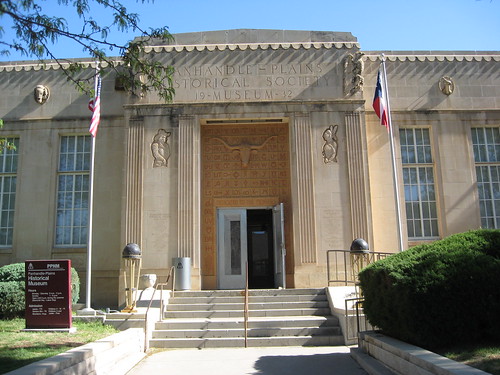 It had been a while since I had been to a museum so when one of my fellow graduate students suggested making a trip to Panhandle-Plains Historical Museum (Wikipedia article) I jumped on the opportunity. He had the option to make the trip a couple of months ago but had decided not to go but back then I had done some research on the museum which made the decision to go even easier when he asked. So early on the morning of May 14th a group of us set off from Lubbock, TX to take the hour and forty-five to two hour trip up to Canyon, TX to the museum.
It had been a while since I had been to a museum so when one of my fellow graduate students suggested making a trip to Panhandle-Plains Historical Museum (Wikipedia article) I jumped on the opportunity. He had the option to make the trip a couple of months ago but had decided not to go but back then I had done some research on the museum which made the decision to go even easier when he asked. So early on the morning of May 14th a group of us set off from Lubbock, TX to take the hour and forty-five to two hour trip up to Canyon, TX to the museum. This museum claims to be the largest history museum in the state of Texas and I would not doubt that it is for a second. This is a pretty impressive for a state that is as obsessed with its history as Texas is. The museum is deceivingly large looking small on the outside and located on the campus of West Texas A&M University in a fairly small town outside of Amarillo, TX. The main focus of the museum is on the Panhandle of Texas.
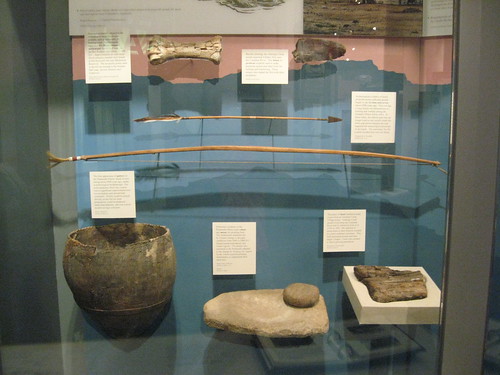 Walking into the museum you get a taste of what you are going to see in the lobby. There is a small display on Native Americans from the region a small paleontology section and a small display on history of European Settlers in the region. It cost about $10 to get in but it was well worth the price.
Walking into the museum you get a taste of what you are going to see in the lobby. There is a small display on Native Americans from the region a small paleontology section and a small display on history of European Settlers in the region. It cost about $10 to get in but it was well worth the price.The first hall we walked through talked about the Native Americans that lived in the area. There were plenty of artifacts used by Native Americans to farm as well as gather and hold water and other important aspects to life. The exhibit was set up based on three aspects for living in the area, which for some reason I can't remember right now, but included things like food water and shelter, for this reason the Native American artifacts were scattered throughout the area. There is a very brief discussion on why farming is possible in the area, pumping water from the Ogallala Aquifer, and some of the harm we are doing to the aquifer by farming using it. While this historical portion is interesting it was actually the reason we went nor is it what I am going to focus on now.
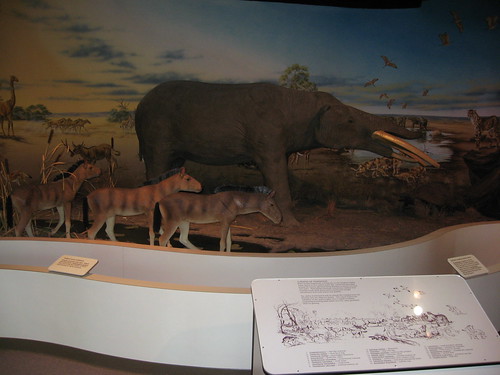 Entering into the paleontology section you are greeted by a large mural with 3 casts in front of it. These represent the panhandle during the age of mammals, I am not sure specifically sorry you get the generic title there, and include a three-toed horse as well as a Gomphothere. There is then a quick summary of life through time starting in the Cambrian and moving through the Permian, in other words the Paleozoic. Each time section has fossils that represent organisms found during those time periods, most of these are small invertebrates and since these times are poorly represented or not represented at all in Texas they are just kind of glanced over. Entering into the Permian there are many fossils that have been found in not just Texas but in the panhandle.
Entering into the paleontology section you are greeted by a large mural with 3 casts in front of it. These represent the panhandle during the age of mammals, I am not sure specifically sorry you get the generic title there, and include a three-toed horse as well as a Gomphothere. There is then a quick summary of life through time starting in the Cambrian and moving through the Permian, in other words the Paleozoic. Each time section has fossils that represent organisms found during those time periods, most of these are small invertebrates and since these times are poorly represented or not represented at all in Texas they are just kind of glanced over. Entering into the Permian there are many fossils that have been found in not just Texas but in the panhandle.Now is a good time to point out that many of the actual fossils in the museum from the panhandle were found during the 30's and 40's by Works Progress Administration (WPA) digs. These digs were "shovel-ready" jobs that President Franklin D. Roosevelt had promised just to give people jobs so they had money so they could spend said money to improve the economy. Many of these fossils came from nearby Palo Duro Canyon State Park (Wikipedia article, and tourist page) which is why they are stored in Canyon, TX. With as many Permian rocks as are in the State Park the Permian fossils are under represented. Part of this is because while Permian fossils are well known from the state they are actually very poorly represented in the Quartermaster Formation, the Permian aged rocks in the state park.
The Triassic fossils do not suffer the same fate. This is because the Triassic is represented by the Dockum Group which in the Panhandle has produced plenty of fossils and still does today, this is the work that the Museum of Texas Tech University Paleontology Division (MoTTU-P) focuses on. So there are plenty of phytosaurs and metoposaurs on display in the Panhandle-Plains Museum. The remainder of the Mesozoic is underrepresented in the Panhandle (there is some Cretaceous aged rock on the South to Southeastern edge of the caprock) so there are very few fossils on display from the Jurassic and Cretaceous. They did have some sauropod fossils, likely casts, as well as a few other Mesozoic casts including the centerpiece of the paleontology wing a cast of Allosaurus. The one area that did anger me was they had the sauropod fossils labeled as "Brontosaurus", for those who don't know "Brontosaurs" has long since been synonomized with Apatosaurus (go type Brontosaurus into Wikipedia), this set out a minor moment of rage, the fact that the skull was of a Diplodocid didn't help much.
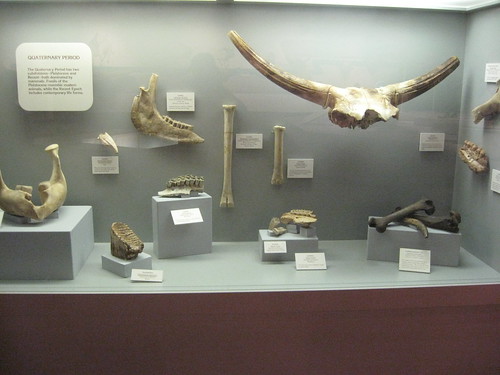 But a major portion of the Paleontology exhibit focused on the fossil mammals that had been found in the area. The panhandle is home to three North American Land Mammal Ages (NALMA); Clarendonian, Hemphillian, and Blancan. These were where many of the fossils were from and there was case after case of fossils from these ages. I can tell that the exhibit hadn't been updated in a while because many of the genus and species names are outdated and have been synonomized with others, I discuss this on the appropriate images in my Flickr set on the museum. I was impressed by this massive display of mammal fossils because this is not typically what you see at most museums but if this is what they have the most of why not. They also had a display talking about horse evolution something which is impressive for West Texas.
But a major portion of the Paleontology exhibit focused on the fossil mammals that had been found in the area. The panhandle is home to three North American Land Mammal Ages (NALMA); Clarendonian, Hemphillian, and Blancan. These were where many of the fossils were from and there was case after case of fossils from these ages. I can tell that the exhibit hadn't been updated in a while because many of the genus and species names are outdated and have been synonomized with others, I discuss this on the appropriate images in my Flickr set on the museum. I was impressed by this massive display of mammal fossils because this is not typically what you see at most museums but if this is what they have the most of why not. They also had a display talking about horse evolution something which is impressive for West Texas.Moving on from the fossils there is a brief overview of the geology of Palo Duro Canyon, something which I am planning a post on since we went there right after the museum. There is then a display on windmills, if you really want to see something on that come down to Lubbock and go to the American Wind Power Center (Wikipedia article), and old cars. The second floor had lots of guns, up through the better part of the Cold War, then a discussion on oil drilling, saddles, and lots of art. The basement had a few hidden gems including taxidermy displays of animals that live or used to live in the area. We did not get to see Pioneer Town because it was being renovated.
Despite its few faults the museum is worth stopping by for anyone in the South Plains and if you are in the area for any reason it is worth stopping by. We got there around 10am and left the museum at 2pm so make sure to leave plenty of time. I also took over 600 pictures, mostly because I am a huge nerd, but make sure you are ready to take lots of pictures. I think the museum gets forgotten about by people who go to Palo Duro State Park but they should really take the time to go see the museum. Sorry this post ended up being so long but when I see a hidden gem I want to make sure other people notice it as well. All images included in the post were taken by the author and if you wish to see more you can go to my Flickr set on the museum or for pictures that include those from Palo Duro my Flickr set that includes both.
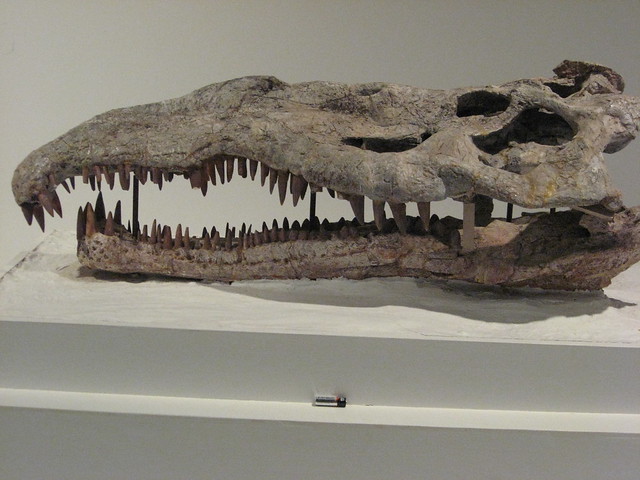
Museum visits page
Friday, May 20, 2011
Lisa P. Jackson on Jon Stewart
The Environmental Protection Agency (EPA) is, in my opinion, one of the most important federal agencies in the United States. This agency not only saves the environment but they also help save people and they assure that people in the United States have clean water to drink and clean air to breath. Hot on the heals of the far right trying to gut the EPA of much of its ability to enforce antipollution measures Lisa P. Jackson, the Administrator of the EPA, was on the Daily Show with Jon Stewart and did an extended interview. She did a great job of explaining what the EPA does, although she was probably just preaching to the choir.
Part 1
Part 2
Part 1
Part 2
Tuesday, May 17, 2011
White Nose Syndrome Update
About a month ago I wrote a post about the future for bats. One of the main things I covered was White Nose Syndrome which if you don't remember is a fungus that effects bats in some caves on the east coast of the U.S. Well today the Fish and Wildlife Service issued a press release talking about White Nose Syndrome.
The National Plan for Assisting States, Tribes and Federal Agencies in Managing White-Nose Syndrome in Bats provides a coordinated national management strategy for investigating the cause of the syndrome and finding a means to prevent the spread of the disease. The service considered approximately 17,000 comments received on the draft plan made available to the public in October 2010.They also launched a new site to keep the public up on the happenings of the fungus. Hopefully with public help/support we can stop the spread of this disease.
Since the syndrome was first documented, the service has been leading a national response that now includes more than 100 state and federal agencies, tribes, organizations and individuals.
Interior Department agencies have invested more than $10.8 million in this effort since 2007. This includes more than $3 million in research funding that is supporting ongoing research projects looking for methods to control or cure the disease.
For example, researchers working with the U.S. Geological Survey have identified Geomyces destructans, a fungus new to science, as the presumed causative agent.
In addition to research, the national response has also developed decontamination protocols to reduce the transmission of the fungus, surveillance strategies, and technical white-nose syndrome diagnostic procedures
Monday, May 16, 2011
Feedback Mechanisms
Greenman3610's newest video discusses orbital forcing and feedback mechanisms and how climate change denialists try to manipulate these ideas to cast doubt on climate change.
Friday, May 13, 2011
I Love Phylogeny
I know that sounds nerdy but I do find phylogeny immensely interesting it shows how interrelated we all are to all the other animals, plants, etc. AronRa has yet another great video this time discussing phylogeny. As with all of his videos it has a lot of technical jargon in it but it is phrased in a way that most people should be able to understand.
Wednesday, May 11, 2011
Help Preserve the Sharktooth Hill Bonebed
While reading this morning's eSkeptic (sign up to receive eSkeptic for free here) I saw this request for help from some very good paleontologists in the L.A. area. While I do not have the ability to help them financially what I do have is a blog to help spread the word so if you can please help them out so we don't lose this important scientific site forever!
We have learned that the world-famous Sharktooth Hill Bonebed fossil locality northwest of Bakersfield, one of the richest and most important sites in the world, is in danger of being sold off to commercial collectors. If this happens, the dealers will excavate it for only the commercially valuable fossils and destroy all the scientific information from the hundreds of sharks, as well as whales and seals and other marine mammals that come from these deposits.
The owner of this land, Bob Ernst (who was a good friend of ours), passed away several years ago suddenly without leaving a will, and his widow is now selling off the fossil-rich property to the highest bidder. Already a lot of important specimens have been sold in auction (including some that were already in a museum collection), and now the Natural History Museum of Los Angeles County is trying to buy one of the most important parcels of Ernst’s property to hold as a scientific preserve (imagine the Page Museum at La Brea Tar Pits, but for marine life). If the museum can raise another $25,000–30,000, they will buy the land. If we collect more than what they need for the land purchase, it will be applied to Phase II of the project, building a visitor’s center. The goal is to preserve the site, while allowing access to schools and non-profit educational groups to help collect the less scientifically significant shark teeth and whale bones. Just imagine that you had been one of the donors who assisted with the acquisition of the La Brea Tar Pits. This is just that type of a once-in-a-lifetime opportunity.
If you would like to make a tax-deductible contribution toward the cause of preserving this legendary locality, please let us know. We must move quickly before the land is sold off and locked away from the public. Dr. John Long of the Natural History Museum has pledged to give a personal tour of the locality, after its purchase, to anyone who donates $2000 or more. You can contact Donald Prothero (Prothero@oxy.edu) or John Long (jlong@nhm.org) for more information. Don’t let this opportunity to preserve such an important place for science pass you by. Please help!
Thank you,
Donald Prothero and Teresa LeVelle
Tuesday, May 10, 2011
Make Your Own Story
I know I am a day late but this comic, from xkcd, was too good not to share. My fiance is a woman in science and while it isn't bad from most fellow scientists but what comes from those on the outside often leaves you wondering. Remember be yourself and make your own story/future.


Algae in Caves
Take a look at these two photographs and other than what they are pictures of see if you can see any major differences (Top picture from Carlsbad Caverns National Park [my post here] bottom picture from Mammoth Cave National Park [my post here]).

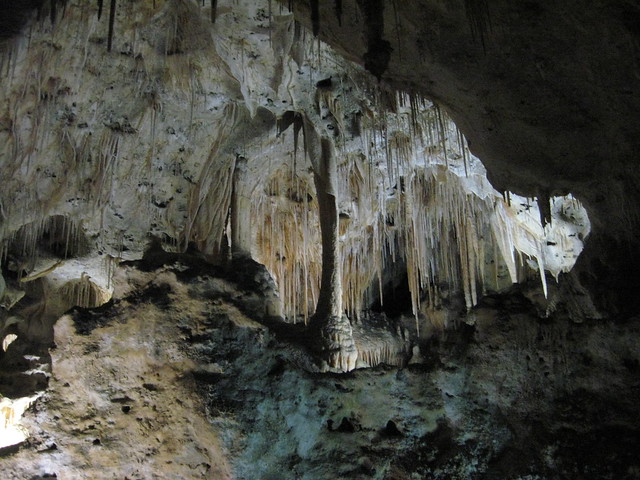
What jumps out to me is the green stain on the wall in the picture from Mammoth Cave. This is something I really noticed while touring the cave and there was some really drastic growth on some of the walls in the New Entrance portion of the cave. According to Smith and Olson (2007) these are some of the 28 species of cyanobacteria, green algae, and/or diatoms. For the rest of this article I will refer to all of these groups as algae, because that is far easier than typing all those out every time. All of these groups are photosynthetic groups that need light as well as moisture to live and since they produce their own food they can grow on cave walls. Algae as well are known as pioneer species meaning, in this case, that they live on rocks, unlike plants which need soil to grow, and in the process they modify the rocks under them by producing weak acids during photosynthesis that break down the rocks they are on. On the surface where algae lives naturally this is a good thing, it is a form of chemical weathering that breaks the bonds that hold the rock together and forms soils in the long run, except in karst areas because it is hard to produce soil from limestone (not going to explain here if you want to know ask). In caves the algae are doing the same thing except that they naturally only occur where the sun shines so in order for them to grow deep down in caves is because we put lights down there.
So why so much more algae in Mammoth Cave than in Carlsbad Caverns? Some of it may have to do with the outside environments of the two areas. Carlsbad is in a desert and Mammoth Cave is in a temperate forest so it is going to be much more moist in Mammoth Cave. Carlsbad does, however, have algae that grows on the surface outside the cave. The main difference has to do with the type of lights that have been installed within the cave. Carlsbad Caverns has been moving toward lights that produce light at a wavelength that the algae cannot grow at (on a side note if you go to the link they talk about how they are changing the lights again and you can see some of that in my pictures). There is still some need to physically remove the algae as the Carlsbad website mentions:
One other interesting thing the Smith and Olson (2007) paper is the only thing I can find about the removal of algae from Mammoth cave and they do not have anything about it on their website nor did they have any signs or did I hear from any of the rangers about it. Carlsbad on the other hand has the quote mentioned above and many of the rangers and signs throughout the cave mentioned the attempts to remove the algae. If I am wrong about this please let me know.
Source:
Smith, T. and R. Olson. 2007. A taxonomic survey of lamp flora (algae and cyanobacteria) in electrically lit passages within Mammoth Cave National Park, Kentucky. International Journal of Speleology. 36(2): 105-114.
(This source can be found here and is open access so the pdf is here)


More photos from Carlsbad Caverns, more photos from Mammoth Cave.
What jumps out to me is the green stain on the wall in the picture from Mammoth Cave. This is something I really noticed while touring the cave and there was some really drastic growth on some of the walls in the New Entrance portion of the cave. According to Smith and Olson (2007) these are some of the 28 species of cyanobacteria, green algae, and/or diatoms. For the rest of this article I will refer to all of these groups as algae, because that is far easier than typing all those out every time. All of these groups are photosynthetic groups that need light as well as moisture to live and since they produce their own food they can grow on cave walls. Algae as well are known as pioneer species meaning, in this case, that they live on rocks, unlike plants which need soil to grow, and in the process they modify the rocks under them by producing weak acids during photosynthesis that break down the rocks they are on. On the surface where algae lives naturally this is a good thing, it is a form of chemical weathering that breaks the bonds that hold the rock together and forms soils in the long run, except in karst areas because it is hard to produce soil from limestone (not going to explain here if you want to know ask). In caves the algae are doing the same thing except that they naturally only occur where the sun shines so in order for them to grow deep down in caves is because we put lights down there.
So why so much more algae in Mammoth Cave than in Carlsbad Caverns? Some of it may have to do with the outside environments of the two areas. Carlsbad is in a desert and Mammoth Cave is in a temperate forest so it is going to be much more moist in Mammoth Cave. Carlsbad does, however, have algae that grows on the surface outside the cave. The main difference has to do with the type of lights that have been installed within the cave. Carlsbad Caverns has been moving toward lights that produce light at a wavelength that the algae cannot grow at (on a side note if you go to the link they talk about how they are changing the lights again and you can see some of that in my pictures). There is still some need to physically remove the algae as the Carlsbad website mentions:
Some of these algae live in the caves, too. Under normal light conditions, they will grow on walls or in pools as far into a cave as the sunlight penetrates (the twilight zone). In caves with artificial light sources of suitable wavelengths, such as Carlsbad Cavern, algae will grow in the dark zones near the lights. These algae are considered pest plants, and are kept under control periodically by park staff.Smith and Olson (2007) point out that most of the work to remove the algae in Mammoth Cave has focused on physical removal using a weak sodium hypochlorite or bleach. This use of bleach can have physical effects on the cave but if the algae is not removed there can be other effects. Smith and Olson (2007) recommend the use of similar lights to what Carlsbad Caverns uses so the algae is unable to photosynthesize and therefore will not be able to produce food and will die without physical damage to the cave.
One other interesting thing the Smith and Olson (2007) paper is the only thing I can find about the removal of algae from Mammoth cave and they do not have anything about it on their website nor did they have any signs or did I hear from any of the rangers about it. Carlsbad on the other hand has the quote mentioned above and many of the rangers and signs throughout the cave mentioned the attempts to remove the algae. If I am wrong about this please let me know.
Source:
Smith, T. and R. Olson. 2007. A taxonomic survey of lamp flora (algae and cyanobacteria) in electrically lit passages within Mammoth Cave National Park, Kentucky. International Journal of Speleology. 36(2): 105-114.
(This source can be found here and is open access so the pdf is here)
Sunday, May 8, 2011
Are There Really More Earthquakes
So as another semester draws to a close you may have noticed a fall off in the amount of blogging I have been doing. Sorry about that I expect to be able to spend more time on it here in the next few days as I finish up finals. But I wanted to post this video by Potholer54 showing that the "increase" in earthquakes we have been having is not a sign of the end times, because there is no increase in earthquakes.
Most of his sources are in the bar under the video but just in case you weren't sure on the amount of earthquakes here is the source he uses for the number:
Most of his sources are in the bar under the video but just in case you weren't sure on the amount of earthquakes here is the source he uses for the number:
United States Geological Survey information on earthquake frequency:
http://earthquake.usgs.gov/earthquakes/eqarchives/year/eqstats.php
Monday, May 2, 2011
Space: At the Current Rate
So I have explained in the past I feel that NASA and space exploration are important to our future. With the Space Shuttle program coming to an end, the last flight of Endeavour will occur once they fix whatever the problem is, xkcd released a comic today showing that by 2035 we will likely have no one alive who has walked on another planet/planetary body/world. Make sure you go to the comic itself and mouse-over the comic, I agree completely with them.


Subscribe to:
Comments (Atom)

